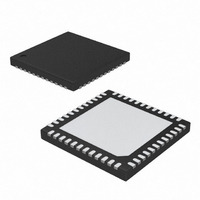MAX8588ETM+T Maxim Integrated Products, MAX8588ETM+T Datasheet - Page 25

MAX8588ETM+T
Manufacturer Part Number
MAX8588ETM+T
Description
IC PMIC HI EFF LOW IQ 48-TQFN
Manufacturer
Maxim Integrated Products
Datasheet
1.MAX8588ETMT.pdf
(31 pages)
Specifications of MAX8588ETM+T
Applications
Processor
Voltage - Supply
2.6 V ~ 5.5 V
Operating Temperature
-40°C ~ 85°C
Mounting Type
Surface Mount
Package / Case
48-TQFN Exposed Pad
Lead Free Status / RoHS Status
Lead free / RoHS Compliant
Current - Supply
-
Lead Free Status / Rohs Status
Lead free / RoHS Compliant
If the capacitor has significant ESR, the output ripple
component due to capacitor ESR is:
Output capacitor specifics are also discussed in the
Compensation and Stability section.
The relevant characteristics for REG1, REG2, and
REG3 compensation are:
1) Transconductance (from FB_ to CC_), gm
2) Current-sense amplifier transresistance, R
3) Feedback regulation voltage, V
4) Step-down output voltage, V
5) Output load equivalent resistance, R
The key steps for step-down compensation are:
1) Set the compensation RC zero to cancel the R
2) Set the loop crossover at or below approximately
For example, with V
REG2, and I
REG2, R
Choose the crossover frequency, f
Choose 100kHz. Then calculate the value of the com-
pensation capacitor, C
Choose 330pF, the next highest standard value.
Now select the compensation resistor, R
droop requirements are met. As an example, if 3% tran-
sient droop is allowed for the desired load step, the
input to the error amplifier moves 0.03 x 1.25V, or
37.5mV. The error-amplifier output drives 37.5mV x
gm
provide transient gain. Find the value of R
the required load-step swing from:
where I
down DC-DC converter, if L
rent relates to inductor current by:
So for an 800mA output load step with V
V
OUT
EA
I
C
1/10th the switching frequency.
C
LOAD
OUT
C
, or I
= 2.5V:
= (V
= (1.25 / 2.5) x (3.125 / 0.75) x (87 x 10
x 100,000)) = 289pF
IND(PK)
CS
pole.
EAO
FB
= 0.75V/A and gm
OUT
V
RIPPLE(ESR)
/ V
R
= 37.5mV x 87µS = 3.26µA across R
is the peak inductor current. In a step-
Dynamic Core for PDAs and Smartphones
C
I
OUT
= 800mA, then R
IND(PK)
= R
______________________________________________________________________________________
Compensation and Stability
) x (R
CS
IN(MAX)
C
:
x I
= 1.25 x I
= I
LOAD
IND(PK)
IDEAL
L(PEAK)
EA
= 5V, V
OUT
/ R
= 87µS.
High-Efficiency, Low-I
OUT
FB
CS
/ I
LOAD
is used, output cur-
, in V
x ESR
EAO
) x (gm / (2π x f
(1.25V)
OUT
C
C
LOAD
= 3.125Ω. For
IN
, so transient-
≤ f
C
= 3.6V and
= 2.5V for
that allows
OSC
EA
CS
= V
-6
/ (6.28
OUT
LOAD
/ 10.
C
C
to
))
/
We choose 240kΩ. Note that the inductor does not limit
the response in this case since it can ramp at (V
V
The output-filter capacitor is then selected so that the
C
For the example:
We choose 22µF.
Recalculate R
Table 4. Compensation Parameters
Table 5. Typical Compensation Values
Loop Crossover Freq (f C )
OUT
OUT
Transconductance, gm EA
COMPONENT OR
Load-Step Droop
Transresistance, R
Output Current
) / L, or (3.6 - 2.5) / 3.3µH = 242mA/µs.
Current-Sense Amp
PARAMETER
C
R
OUT
Error-Amplifier
R
LOAD
PARAMETER
Inductor
R
C
C
V
LOAD
C
R
R
OUT
OUT
= R
C
C
= R
C
(1.25 x 0.8A) / 3.26µA = 230kΩ
pole cancels the R
C
3.125Ω = 25µF
= C
CS
C
C
using the selected C
= V
OUT
x C
OUT
3.125Ω
x I
OUT
IND(PK)
C
CS
x R
x R
/ R
x I
LOAD
LOAD
1300mA
LOAD
LOAD
100kHz
Q
240kΩ
REG1
330pF
3.3µH
22µF
3.3V
3%
/ I
0.5V/A
EAO
REG1
= R
87µS
PMIC with
= 240kΩ x 330pF /
/ C
= 2.5V / 0.8A =
C
C
C
C
= (0.75V/A) x
C
x C
= 208kΩ
OUT
100kHz
900mA
240kΩ
REG2
270pF
6.8µH
22µF
zero:
2.5V
3%
0.75V/A
C
REG2
87µS
.
100kHz
500mA
240kΩ
REG3
330pF
1.25V/A
10µH
22µF
REG3
1.3V
68µS
3%
IN
25
-











